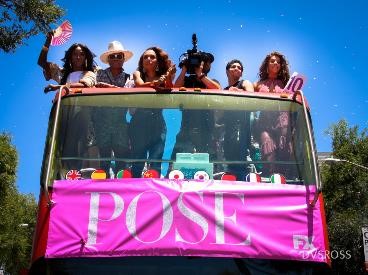Understanding Inclusive Representation
|
Inclusive representation refers to the fair, accurate, and respectful portrayal of diverse groups of people in media, including individuals of different races, ethnicities, genders, sexual orientations, abilities, ages, and socioeconomic backgrounds. It ensures that all segments of society are visible, and their stories are told authentically and without stereotypes. Inclusive representation not only reflects the reality of a diverse world but also provides marginalized groups with the opportunity to see themselves in a positive and empowered light. It promotes equality, fosters empathy, and challenges biased narratives by embracing a wide range of perspectives and experiences. |
 |
|
The historical context and evolution of media representation reflect how various groups—especially marginalized communities—have been portrayed (or excluded) in media over time, and how those portrayals have changed.
Early media and stereotypes In the early days of film, television, and literature, many groups were either underrepresented or misrepresented. Common portrayals often relied on stereotypes that reinforced harmful biases. For instance:
|
|
Color cover of the book Tarzan of the Apes (1912), written by Edgar Rice Burroughs and published as a novel in 1914. The Tarzan novels (and later films) often depicted African natives as primitive and uncivilized, reinforcing colonialist stereotypes of African people as inferior or savage. Theatrical release poster for The Birth of a Nation (1915), distributed by Epoch Film Co. This controversial film reinforced racist stereotypes by portraying African Americans as dangerous and corrupt, while glorifying the Ku Klux Klan. |
||
|
Mid-20th Century shifts The mid-20th century saw the rise of movements like civil rights, women’s liberation, and LGBTQ activism, which challenged the limited and harmful depictions of these communities. Media slowly began to respond. |
 |
Cover of The Well of Loneliness (1928) by Radclyffe Hall. One of the earliest works depicting LGBTQ themes, this novel was met with controversy and censorship, reflecting the negative attitudes toward queer identities in early media. | ||
|
1950s and 60s The 1950s and 60s saw the emergence of characters of color in more positive roles, though stereotyping and tokenism persisted. |
 |
Star Trek: The Original Series (1966-1969) broke new ground with diverse casting, including Nichelle Nichols as Uhura (photo by Alan Light), one of the first Black women in a significant role in American television. It was also notable for the first interracial kiss on TV. |
||
|
1970s The 1970s brought more representation of women in the workplace and non-traditional roles, as well as increased visibility for people of color in TV shows like The Jeffersons or Good Times. |
 |
Publicity photo of American actors Isabel Sanford, Sherman Hemsley and Mike Evans promoting the upcoming January 18, 1975 premiere of the television series The Jeffersons. One of the first TV series to focus on an affluent African American family, breaking away from the stereotypical portrayals of Black people in lower socioeconomic roles. |
||
|
1980s LGBTQ representation started emerging in the 1980s, but it was often marked by negative connotations, like portraying gay men primarily in the context of the AIDS crisis. |
 |
Jack Coleman was one of the actors who played Steven Carrington in the Dynasty (1981-1989) TV series. Although the portrayal of LGBTQ characters was still problematic, the character of Steven Carrington was one of the first regular gay characters on primetime TV, albeit framed through negative and stereotypical narratives. (cropped version of the photo by Anthony Citrano for Flickr, under CC-BY-2.0) |
||
|
1990s and 2000: expanding representation The 1990s and 2000s marked a turning point toward more inclusive and varied representation:
|
 |
Cast of the TV series “Buffy the Vampire Slayer” (1997-2003). Buffy was a groundbreaking character who challenged traditional gender roles, presenting a strong, independent female lead who could fight both literal and metaphorical demons. (photo by Patrick Lee, under the license CC-BY-2.0) |
Current Trends: Toward True Inclusivity
Today, there is an increasing demand for authentic and multidimensional representation. This includes:
- Intersectionality: recognizing that people’s identities are complex, media has started reflecting characters who embody multiple facets of identity (e.g., race, gender, and sexuality).
- Diverse storytelling: Stories now highlight a wider range of lived experiences. Films like Black Panther and Crazy Rich Asians showcase cultural pride and nuance, while TV shows like Pose feature transgender people of color in leading roles.
- Behind-the-scenes inclusion: There’s greater attention to the diversity of creators, writers, and directors, ensuring more authentic storytelling.
Overall, the evolution of media representation reflects broader societal changes. While progress has been made, there is still work to be done to achieve truly inclusive, equitable representation across all media.
|
The legal framework of inclusive representation in the media is shaped by laws, regulations, and policies that aim to promote equality, prevent discrimination, and ensure fair representation of diverse groups. These frameworks vary by country but typically focus on preventing harmful stereotypes, ensuring non-discrimination, and promoting diversity in media content and production. EU Framework
|
 |
Other countries (examples)
- Spain: Spanish General Audiovisual Communication Law. This law aligns with the AVMSD, promoting gender equality, cultural diversity, and respect for individuals’ rights. It includes provisions that ensure equal treatment and prevent discriminatory content in Spanish media.
- France: Freedom of Communication Act. This act, in line with EU directives, emphasizes cultural diversity in French media and prohibits discriminatory content. It also promotes the representation of minority languages and cultures.
- Poland: Polish Broadcasting Act (1992). This law governs the national media landscape, requiring broadcasters to respect human dignity and avoid content that incites discrimination. However, enforcement of diversity standards is less comprehensive compared to other EU countries, with limited provisions for minority representation.
Importance of Diversity in Representation
|
Diverse narratives have a profound impact on society, shaping perceptions, fostering empathy, and promoting a more inclusive understanding of the world. In media, literature, film, and other forms of storytelling, diverse narratives challenge dominant viewpoints, elevate marginalized voices, and encourage more nuanced and complex portrayals of individuals and communities. Key ways in which diverse narratives hold power:
|
 |
- Fostering empathy and understanding
Stories that reflect diverse experiences allow audiences to step into the shoes of others, fostering empathy. When people encounter narratives that highlight different cultural, racial, or social realities, they are more likely to develop an understanding and appreciation for experiences outside their own. - Reflecting the complexity of human experience
Diverse narratives show that life is multifaceted, encompassing not only gender, race, and culture but also intersections of identity—such as the combination of class, religion, ability, and sexuality. These stories offer audiences a more holistic understanding of what it means to navigate the world. - Empowering marginalized communities
When media and literature include authentic, positive representations of marginalized groups, those communities feel seen, validated, and empowered. Representation provides role models, affirms identity, and can counteract feelings of exclusion. Diverse narratives help dismantle societal barriers by showing individuals from these communities as multidimensional, capable, and resilient. - Promoting social change
Diverse narratives can drive social change by sparking conversations about inequality, justice, and human rights. When stories highlight systemic issues—such as racism, sexism, or ableism—they draw attention to these problems and can inspire collective action toward solutions. - Broadening creative and cultural horizons
Diverse storytelling enriches the creative landscape, offering new themes, voices, and traditions to the broader media and literary world. - Countering the dominance of a single narrative
For much of history, mainstream media and literature have been dominated by narratives created by and for a narrow demographic, often centered on white, male, heterosexual experiences. Diverse narratives counter this by offering stories that include a wider array of experiences, pushing back against the idea that there is only one "universal" experience or way to tell a story. - Economic benefits of diversity
In addition to social and cultural benefits, diverse narratives can also generate significant economic value. Audiences are increasingly demanding content that reflects their realities, and media that embraces diversity has often seen greater commercial success.
|
TV: Pose (2018-2021) Pose made history by featuring the largest-ever cast of transgender actors in series regular roles, alongside a diverse supporting cast. Set in the ballroom culture of 1980s New York, the show explores issues facing LGBTQ people of color, including HIV/AIDS, discrimination, and poverty. |
 |
|
Photo by DVSROSS in Flickr under the Creative Commons Attribution 2.0 Generic license. |
|
|
Literature: The Hate U Give (2017) This young adult novel by Angie Thomas tells the story of Starr Carter, a Black teenager who witnesses the police shooting of her best friend, and her struggle to speak out against systemic racism. The book presents the realities of police violence, racial profiling, and the Black Lives Matter movement, while centering a young Black female protagonist. The novel became a bestseller and was adapted into a successful film. |
|
Author of The Hate U Give. Photo by Valder Beebe Show under Creative Commons Attribution 3.0 Unported license. |
||
|
Film: Encanto (2021) Encanto celebrates Colombian culture, featuring an ethnically diverse cast of characters in a magical realist setting. The film highlights a multigenerational Latinx family and addresses themes like family dynamics, mental health, and personal identity. The characters’ diverse skin tones and appearances reflect the rich racial and ethnic diversity of Colombia. |
|
Barichara, Colombia. Image by Bernard Gagnon under the Creative Commons Attribution-Share Alike 4.0 International license. Quindío, Cocora Valley and Barichara in Santander were some of the places that the Encanto production team visited in Colombia to develop the film. |
||
|
Videogames: The Last of Us Part II (2020) The Last of Us Part II was praised for its diverse characters and its representation of LGBTQ relationships. The game features a complex female protagonist, Ellie, who is openly gay, and showcases a variety of characters across different races, genders, and abilities. It also includes Lev, a transgender character, offering one of the most prominent trans portrayals in gaming history. |
|
Marketing on a train for The Last of Us Part II. Photo by Pete Ellis under the Creative Commons Attribution-Share Alike 4.0 International license. |
||
|
Advertising: Gillete – The Best Men Can Be (2019) Gillette’s "The Best Men Can Be" campaign redefined masculinity by addressing issues such as toxic masculinity, bullying, and sexual harassment. The advertisement encouraged men to challenge outdated norms and embrace positive behaviors, portraying men in non-traditional, empathetic, and nurturing roles. |
Advertising "The Best Men Can be", by Gillete. |
Creating Inclusive Content
Creating inclusive stories is a deliberate process that requires thoughtful consideration of different identities, experiences, and perspectives. Key guidelines for developing stories that are authentically inclusive:
- Research and understand the communities you are representing. Conduct thorough research, engage with primary sources, and consult individuals from those communities. This includes reading literature, watching documentaries, and conducting interviews or consultations to gain nuanced insights.
- Avoid stereotypes. Develop multidimensional characters with rich backstories, motivations, and complexities. Ensure that diverse characters have meaningful roles and are not included just to "tick a box."
- Avoid “the single story” trap. No group or culture is monolithic. Show diversity within the group you’re representing by including characters with different backgrounds, perspectives, and experiences. This helps reflect the true complexity of human life.
- Incorporate intersectionality. Think about how aspects like race, gender, class, sexuality, and ability interact in the characters’ lives. Create characters who reflect this complexity rather than focusing on one dimension of their identity.
- Acknowledge and avoid harmful tropes. Be aware of problematic tropes and work actively to subvert or avoid them. Research common tropes used in media and learn how to write more progressive, empowering narratives.
- Show the reality of bias without exploiting trauma. Handle themes of discrimination thoughtfully and balance these stories by showing characters’ strength, community, and joy. Let the story offer hope, healing, or resistance, rather than being a purely negative portrayal.
- Be consciuous of language. Use inclusive, respectful language that aligns with how communities identify themselves. Avoid outdated or offensive terms, and ensure you’re informed about appropriate terminology for different groups.
- Don’t exoticize or objectify cultures. Treat cultural traditions and identities with respect. Show them in a context that reflects their full meaning and significance, without sensationalizing or romanticizing them for dramatic effect.
- Be open to feedback and criticism. Be willing to listen to critiques from underrepresented groups, especially if they feel misrepresented or marginalized in your story. Use this feedback to learn and improve your approach in future works.
Creating inclusive visual and audio representation in media is essential for ensuring that diverse audiences feel seen, heard, and understood. It involves making deliberate choices about how people are portrayed and how sounds are used, respecting the authenticity and individuality of characters from different backgrounds, identities, and experiences. Key guidelines:
- Diverse casting and authentic portrayals. Ensure that actors from diverse racial, cultural, gender, and ability backgrounds are cast in roles that reflect their experiences. Avoid “whitewashing” or misrepresentation, where characters from certain backgrounds are played by actors from other, often privileged, groups.
- Representation of body types and appearance. Show characters of different body types, skin tones, facial features, and physical abilities. Avoid emphasizing unrealistic body ideals and celebrate the full spectrum of human appearance.
- Accurate representation of physical ability. Show people with disabilities authentically, using real actors when possible. Portray the range of disabilities (physical, cognitive, sensory) in a way that emphasizes the individual’s personality and capabilities, not just their disability.
- Diverse accents, dialects and languages. Use voice actors or on-screen talent that represent the authentic accents, dialects, or languages of the characters. Avoid accent-based stereotypes, and don’t use accents as a comedic or villainous tool
- Inclusive music choices. Choose music that authentically represents the cultures, eras, and experiences of the characters. Use composers and musicians from the cultures represented in the story, and avoid appropriating cultural music without context or understanding. Be mindful of including a range of genres to reflect diverse musical traditions.
- Representation of sign language and captioning. Incorporate sign language, subtitles, and closed captioning in a way that feels natural and inclusive. Ensure that on-screen signing or audio description is integrated into the storytelling, and not just added as an afterthought. Characters who use sign language should be portrayed accurately, with attention to real-world communication methods.
 |
Inclusive representation ensures that diverse identities and experiences are authentically portrayed in media, reflecting the full spectrum of society. |
 |
 |
Diverse stories challenge stereotypes, broaden perspectives, and help build empathy among audiences. |
 |
Historical context shows that media has often misrepresented marginalized groups, but modern efforts aim to rectify this with more inclusive narratives. |
 |
Avoiding stereotypes and tokenism is crucial for creating multidimensional, meaningful characters and storylines. |













